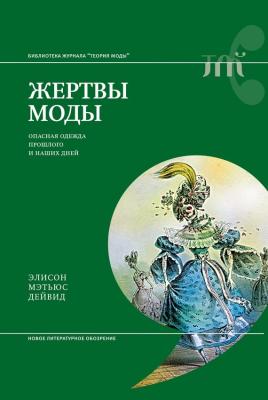Жертвы моды. Опасная одежда прошлого и наших дней. Элисон Мэтьюс Дейвид
Читать онлайн.| Название | Жертвы моды. Опасная одежда прошлого и наших дней |
|---|---|
| Автор произведения | Элисон Мэтьюс Дейвид |
| Жанр | Документальная литература |
| Серия | Библиотека журнала «Теория моды» |
| Издательство | Документальная литература |
| Год выпуска | 2015 |
| isbn | 978-5-4448-0856-6 |
58
Raoult D. et al. Evidence for Louse-Transmitted Diseases in Soldiers of Napoleon’s Grand Army in Vilnius // Journal of Infectious Diseases. 2006. Vol. 193. No. 1. P. 112-120.
59
Ibid.
60
Bahier H. Les épidemies en temps de guerre: Le typhus éxanthématique “maladie de misère”. Montpellier: Firmin et Montane, 1919. P. 57.
61
Цит. по: Bahier. P. 36.
62
Moore W., Hirschfelder A. An Investigation of the Louse Problem. Minneapolis: University of Minnesota Press, 1919. P. 26
63
Ibid. P. 27.
64
Peacock A. D. The Louse Problem at the Western Front (Part II) // British Medical Journal. 1916. May 26. P. 749.
65
Gibson B. The March of the Cooties. Chicago: Robert L. Gibson, 1918.
66
Yellen J., Olman A. The Cootie Tickle Shimmie Dance // Sheet Music. New York: Feist, 1919. (Танец «шимми» появился под влиянием афроамериканских традиционных плясок и получил распространение в США в 1910-1920-х годах. Характерная фигура танца представляет собой извивающееся движение телом, как будто танцующий пытается сбросить с себя застегнутую рубашку. – Прим. пер.)
67
Byam W. Trench Fever: A Louse-Borne Disease. London: Oxford University Press, 1919. P. 125.
68
Ibid. P. 128.
69
В 2007 году военнослужащий армии США заразил своего двухлетнего сына оспой. Инфекция может передаваться не только через фомиты – предметы, бывшие в контакте с патогенными микроорганизмами и потенциально опасные для людей и животных. В описываемом случае это были домашние тапочки и полотенца. Вирус может жить на любых других поверхностях в доме в течение недели. Marcinak J. et al. Household Transmission of Vaccinia Virus from Contact with a Military Smallpox Vaccinee – Illinois and Indiana, 2007 // MMWR. 2007. Vol. 56. No. 19. P. 478-481.
70
McConnell M. A Country Between: The Upper Ohio Valley and Its Peoples, 1724-1774. Lincoln: University of Nebraska Press, 1992. P. 194.
71
Это выдержки из дневника офицера Уильяма Трента. Цит. по: Pen Pictures of Early Western Pennsylvania / Ed. John W. Harpster. Pittsburgh: University of Pittsburgh Press, 1938. P. 99, 103-104.
72
McConnell M. Op. cit. P. 195.
73
Wald P. Contagious: Cultures, Carriers, and the Outbreak Narrative. Durham: Duke University Press, 2008. P. 12.
74
Ibid. P. 13.
75
Tomes N. The Gospel of Germs: Men, Women, and the Microbe in American Life. Cambridge: Harvard University Press, 1998. P. 205.
76
Sir Robert Peel’s Daughter // Huron Expositor. 1891. July 3. P. 6.
77
Ibid.
78
Punch. 1850. January. P. 38.
79
Цит. по: Perrot P. Fashioning the Bourgeoisie. Princeton: Princeton University Press, 1994. P. 115.
80
What the “Sweater” said to the Swell // Punch (Melbourne). 1874. August 13. P. 327.
81
Tomes N. Op. cit. P. 218.
82
Gibert E. Influence du commerce des chiffons et vêtements non désinfectés sur la propagation de la variole et autres maladies contagieuses. Marseille: Barlatier-Feissat, 1879. P. 10.
83
Farrell-Beck J., Callan-Noble E. Textiles and Apparel in the Etiology of Skin Diseases // International Journal of Dermatology. 1998. Vol. 37. No. 4. P. 309-314.
84
Infected Clothing // Journal of the American Medical Association. 1899. Vol. XXXII(16). April 22. P. 887.
85
Rapport de MM. Pasteur et Léon Colin au conseil d’hygiène publique et de salubrité, Établissement, Paris, d’étuves publiques pour la désinfection des objets de literie et des linges qui ont été en contact avec des personnes atteintes de maladies infectieuses ou contagieuses. Paris: Publications de la Préfecture de Police, 1880.
86
Ibid.
87
Цит. по: Newman L. A Reader’s Guide to the Short Stories of Nathaniel Hawthorne. Boston: G. K. Hall, 1979. P. 364. (Готорн Н. Новеллы / Пер. с англ. М.; Л.: Худож. лит. [Ленингр. отд-ние], 1965.)
88
Septic Skirts // The Lancet. 1900. June 2. P. 1600.
89
The Dangers of Trailing Skirts // Current Lit. 1900. Vol. 29. P. 433; The Scavenger Skirt // Canadian Magazine. 1906. Vol. 27. P. 471-472.
90
Tomes N. Op. cit. P. 157.
91
Ditchburn I. Should Doctors Wear Ties? // Journal of Hospital Infection. 2006. Vol. 63. P. 227.
92
Lopez
